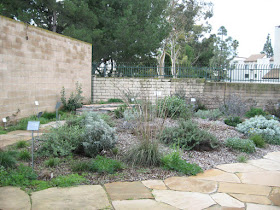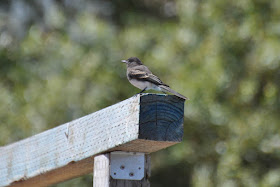Over
the past few months we’ve discussed urban soils (September 2012), soil testing
(October 2012) and soil amendments (November 2012). We end the year by considering soil drainage. Next month we’ll present one final soils topic
- the soil as a living, productive ecosystem.
If
you’ve done a soil perc test you now know whether your soil drains quickly,
slowly or somewhere in between. Depending
on your results, you may decide to select
appropriate plants based on their drainage needs. Alternatively, you may choose to alter the
drainage of parts of your garden. As always, your gardening choices are unique
to your own situation. Our goal at Mother Nature’s Backyard is to help you make
informed choices.
 |
| Image courtesy of http://www.salinitymanagement.org/ Salinity%20Management%20Guide/ds/ds_7.html |
Soil
drainage is determined by pore spaces. Soil
pores are spaces that are filled with either air or water (see picture
above). Most soils have a combination of
large and small pore spaces. Under normal
conditions, larger pores are filled with air and smaller pores with water. This is good because plant roots and most
soil organisms need ready access to both air (oxygen) and water.
Being
composed of relatively large soil particles, sandy soils have more large and fewer
small pores than soils with more silt and clay particles. The abundant large
pores fill quickly, allowing sandy soils to take up water more easily than clay
soils. On the flip side, large pores don’t
retain water as well, so sandy soils also dry out more quickly.
Soils
that drain quickly present several challenges.
First, they require more frequent watering, particularly during hot,
windy weather. These soils also leach
out soil nutrients more quickly. Nutrient
leaching occurs for two reasons: 1) water percolates through sandy soils more
quickly, taking with it dissolved minerals and 2) clay, silt and humus
(organic) particles attract soil minerals (via a small electro-magnetic charge)
and hold them better than do sand particles.
As
a result of leaching, sandy soils may have lower levels of key nutrients like
nitrogen, phosphorus and iron. Growing plants with high nutrient requirements
(like many vegetables and citrus trees) in sandy soils requires routine
application of fertilizers or compost.
Fortunately, many Southern California native plants have low nutrient
needs and are well-suited to sandy or rocky soils, even without fertilization. For a list of native plants suitable for
sandy soils see: http://www.nbs.csudh.edu/biology/projectsound/habitat/documents/Sandy_Soils-3-11.pdf
On
the positive side, very well drained soils hardly ever become saturated (water-logged). Clay and silty soils have fewer large pore
spaces (and more small pores), so they take up water more slowly – but retain
soil moisture longer. These soils also
have positive and negative characteristics with regards to drainage.
Slowly
draining soils require less irrigation and retain nutrients better. But they have the potential to become
water-logged during wet winters or with over-watering. Water-logged soils deprive roots of oxygen; plants
growing on wet soils tend to be shallow rooted.
Prolonged exposure to water-logged soils can be hazardous to plant
health and even lead to death. Plants
that need well-drained soils – including many California native plants – are particularly
vulnerable. These plants often do well in
clay soils until their first El Niño year, when they suddenly yellow and die. They’ve literally ‘drowned’ in the water saturated
soil.
On
the other hand, slowly draining soils are perfect for a wide range of
interesting native plants. These include
plants that normally grow around lakes or streams as well as those from our
local seasonal (vernal) marshes and vernal pools (see http://www.nbs.csudh.edu/biology/projectsound/habitat/documents/Clay_Soils-3-11.pdf
and http://www.nbs.csudh.edu/biology/projectsound/habitat/documents/Riparian_Palette-3-11.pdf
). If you have a slow-draining soil,
consider yourself lucky! People with quickly
draining soils can only grow such plants in containers
Compacted
soils can be a challenge in local gardens.
Compacted soils (see above) often lack sufficient large pores. This explains several characteristics of
compacted soils. First, they tend to be
low in oxygen compared to non-compacted soils.
This usually only becomes a problem during periods of prolonged heavy
rains or when compacted soils are over-watered. Compacted
soils also tend have slow water uptake, leading to runoff. If you have badly compacted soils – or have a
hardpan layer beneath the topsoil - you may want to try one of the methods
suggested below.
Our
approach to gardening at Mother Nature’s Backyard emphasizes respecting the
forces of nature and working with existing conditions. We’ve come to that philosophy in part for
scientific reasons; we believe it’s
important to conserve and restore natural landscapes for their beauty, habitat
value and sense of place. But we’re also pragmatic. It’s often easier to work with what you have – by choosing
appropriate plants and watering methods – than to change your soil
dramatically. That being said, there are
a few, relatively simple things you can do that will allow you to grow plants
that normally require soils that have faster (or slower) drainage than your
garden’s soil.
Garden in Raised Beds, Containers & Planters
One of the easiest ways to provide soil with
specific characteristics is to garden in raised beds, containers and
planters. These contained environments
allow you to create exactly the right soil mix.
You can create soils with better drainage if you want to grow cacti or
plants that require sandy or rocky soils. You can provide slowly draining soils
for marsh or bog plants. Or you can
create a light, well-drained mix with high organic and nutrient content for
growing garden vegetables.
Container gardening is fun and can be done in
almost any garden. There are a few
tricks to gardening in containers and raised beds. Fortunately, there are many good books and
internet resources to get you started.
Create Micro-berms to Increase Soil Drainage
 |
| Central berm before planting (view looking south). Note gentle slope. |
Micro-berms are 1-2 feet taller than the
surrounding soil and of any size or shape.
In general, rounded curved shapes with gently
sloping sides are most attractive. The photo above shows our central berm in
Mother Nature’s Backyard. It’s about 20
feet across and gently curved in shape. The
central berm is about 2 ½ feet taller than the rest of the garden at its
highest point and slopes gently down to the north and east. We grow local Salvias (Sages), California
Sagebrush, native Buckwheats and Penstemons on our central berm. These plants like good drainage and we have
clay-loam soil with moderate drainage.
We provide better drainage with our central berm. The plants that need the best drainage are
planted at the top.
 |
| Central berm as it looks today - view looking west |
Micro-berms needn’t be large. Below is a photo of our small ‘Salvia Berm’
which looks more like a pitcher’s mound than a large berm. Our ‘Salvia berm’ is only about 1 ft. tall
and perhaps 6 feet across. When the plants mature you won’t even know it’s
there.
 |
| The small 'Salvia Berm' is circled |
If your soil drains slowly, you may be tempted to create
micro-berms using imported topsoil. Imported soils may improve drainage and often
can be delivered (and dumped) in place in your garden. But
you’ll need to insure that the better-draining imported soil doesn’t just sit
atop the slower-draining native soil, creating an impermeable layer.
When creating a berm with imported soil, mix some
of the imported and native soils and create a mixed-soil layer between the berm
and native soil. Ideally, this layer
should be at least 12 inches deep, though even 6 inches will be of benefit. If you cannot create a mixed layer, at the
very least you should break up the top layer of native soil before creating your
berm. Taking these steps – or using soil
that is the same or similar to the native soil – will insure that your berm
drains properly.
Create Small Depressions to Increase Water Retention
You can also increase the water-holding capacity of a soil by creating
shallow depressions where water can collect. This is particularly helpful in well-drained
soils. Such depressions are sometimes
called swales, although true drainage swales and rain gardens require
a little more thought and engineering.
Simple depressions don’t have to be deep – several inches below the rest
of the garden will do. Be sure to gently
slope the sides so you don’t create a safety hazard. Then grow plants that need a little more water in
these depressions.
Add Organic Materials (unless the plants need nutrient-poor soils)
Consider adding compost to your vegetable garden or
non-native flower beds. Compost adds
nutrients while increasing the soil’s ability to hold water. Organic particles (humus) create small soil
pores and also decrease the leaching of nutrients. They are a normal part of most mature soils. Even organic mulches (see July, 2012
posting) contribute organic materials to the soil as they break down. At
least a 1 percent increase in organic matter is required to have an effect on
the water- and nutrient-holding capacity of a soil.
Drill Holes Through a Hardpan Layer
If you have a clay or hardpan layer, you may want
to consider drilling holes through it.
First test your soil to be sure that a hard, compacted or impermeable
layer is the cause of your drainage problems (see October 2012 posting on ‘Testing
Your Soil’). This will also indicate the
location and depth of the compacted layer. Use a soil auger to drill a series of holes
through the hardpan. See the following
for more: http://ceventura.ucanr.edu/Gardening/Coastal/Landscape_578/Hardpan/
.
Frequently Asked
Questions
Do
I need to change my soil’s drainage properties?
No. If you have a well-drained
soil, no action is needed. If your soil drains quickly or slowly, you can
select plants appropriate for your sandy or clay soil. Most local soils support a wide range of
native and non-native plants.
Should I rototill or double-dig my garden before
planting to improve drainage? In most cases, the answer is no. While these methods have long been used for intensive
vegetable gardening, they may actually do more harm than good for many local
soils. We’ll discuss this more in our
January 2013 posting. These methods also bring up buried weed seeds.
Can I improve drainage with ‘lasagna gardening’? ‘Lasagna gardening’ involves double-digging then
layering cardboard/newspaper strips and green materials that decompose over
time. The method is sometimes
recommended for gardens with thin/no topsoil – usually in places with far more
precipitation than we get. The ‘lasagna’ method does not improve drainage
in most local soils – in fact it may decrease it. Like any double-digging method, it also
destroys the natural soil layers that build up over time. We don’t recommend this method. See https://sharepoint.cahnrs.wsu.edu/blogs/urbanhort/archive/2011/03/30/is-quote-lasagna-gardening-quote-really-worth-the-effort.aspx for more.
Do I need to ‘loosen’ my soil every year? Once again, the answer is usually no. Soil
around trees, shrubs and other permanent plantings is better off left
alone. Use a layer of mulch if
appropriate, but don’t dig to improve drainage. You may want to loosen the soil in your
vegetable garden or garden beds containing non-native flowers that are
routinely replaced. Adding
compost will also help to improve drainage in soils that are used intensively.
Additional Resources
Send your garden soils questions to mothernaturesbackyard10@gmail.com or post a comment below.
















